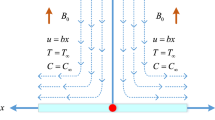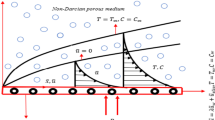Abstract
This article presents the study of two-dimensional hydromagnetic stagnation point flow of Casson nanofluid over a stretching sheet in a non-Darcy porous medium with binary chemical reaction stimulated by Arrhenius activation energy. The energy equation is obtained by considering the production of heat due to Joule and viscous dissipations, heat generation/absorption and thermal radiation of the liquid. The flow model is developed and presented in the form of a system of nonlinear partial differential equations together with appropriate boundary conditions. The particle flux at the sheet is taken to be zero. The leading PDEs are transformed into dimensionless coupled ordinary differential equations (ODEs) by the usual procedure of transformation. The obtained ODEs are solved using optimal homotopy analysis method, and the effects of underlying parameters on the fluid velocity, temperature, concentration, entropy generation and Bejan number are demonstrated with the help of graphs. Also, the numerical values of skin friction coefficient, Nusselt number and Sherwood number are presented in tabular form. Linear as well as quadratic regression analysis for quantities of physical interest has also been carried out. Entropy generation is perceived to rise on increasing diffusive variable and Brinkman number, whereas Brownian diffusion has an adverse effect on it. Skin friction coefficient is reduced on increasing Casson fluid parameter and activation energy.



























Similar content being viewed by others
References
Heris SZ, Esfahany MN, Etemad SG (2007) Experimental investigation of convective heat transfer of Al\(_2\)O\(_3\)/water nanofluid in circular tube. Int J Heat Fluid Flow 28:203–210
Turkyilmazoglu M (2012) Exact analytical solutions for heat and mass transfer of MHD slip flow in nanofluids. Chem Eng Sci 84:182–187
Sandeep N, Reddy MG (2017) Heat transfer of nonlinear radiative magnetohydrodynamic Cu-waternanofluidflow over two different geometries. J Mol Liq 225:87–94
Tripathi R, Seth GS, Mishra M (2017) Double diffusive flow of a hydromagnetic nanofluid in a rotating channelwith Hall effect and viscous dissipation: active and passive control ofnanoparticles. Adv Powder Technol 28:2630–2641
Kumar A, Singh R, Seth GS, Tripathi R (2018) Double diffusive magnetohydrodynamic natural convection flow of brinkman type nanofluid with diffusion-thermo and chemical reaction effects. J Nanofluids 7:338–349
Munyalo JM, Xuelai Z (2018) Particle size effect on thermophysical properties of nanofluid and nanofluid based phase change materials: a review. J Mol Liq 265:77–87
Hamid M, Usman M, Zubair T, Haq RU, Wang W (2018) Shape effects of MoS\(_2\) nanoparticles on rotating flow of nanofluid along astretching surface with variable thermal conductivity: A Galerkinapproach. Int J Heat Mass Transf 124:706–714
Bejan A (1980) Second law analysis in heat transfer. Energy 5:720–732
Nouri D, Pasandideh-Fard M, Oboodi MJ, Mahian O, Sahin AZ (2018) Entropy generation analysis of nanofluid flow over a spherical heatsource inside a channel with sudden expansion and contraction. Int J Heat Mass Transf 116:1036–1043
Rashidi M, Kavyani N, Abelman S (2014) Investigation of entropy generation in MHD and slip flow overa rotating porous disk with variable properties. Int J Heat Mass Transf 70:892–917
Reddy GJ, Kethireddy B, Kumar M, Hoque MM (2018) A molecular dynamics study on transient non-Newtonian MHD Cassonfluidflow dispersion over a radiative vertical cylinder with entropyheat generation. J Mol Liq 252:245–262
Adesanya SO, Makinde OD (2014) Entropy generation in couple stress fluid flow through porous channel with fluid slippage. Int J Exergy 15:344–362
Seth GS, Kumar R, Bhattacharyya A (2018) Entropy generation of dissipative flow of carbon nanotubes in rotating frame with Darcy–Forchheimer porous medium: a numerical study. J Mol Liq 268:637–646
Mahian O, Kianifar A, Kleinstreuer C, Mohd A AN, Pop I, Sahin AZ, Wongwises S (2013) A review of entropy generation in nanofluid flow. Int J Heat Mass Transf 65:514–532
Hayat T, Farooq S, Ahmad B, Alsaedi A (2017) Effectiveness of entropy generation and energy transfer on peristalticflow of Jeffrey material with Darcy resistance. Int J Heat Mass Transf 106:244–252
Bestman A (1990) Natural convection boundary layer with suction and mass transfer in a porous medium. Int J Energy Res 14:389–396
Ramzan M, Ullah N, Chung JD, Lu D, Farooq U (2017) Buoyancy effects on the radiative magneto Micropolar nanofluid flow with double stratification, activation energy and binary chemical reaction. Sci Rep 7:12901
Awad FG, Motsa S, Khumalo M (2014) Heat and mass transfer in unsteady rotating fluid flow with binary chemical reaction and activation energy. PLoS ONE 9:e107622
Khan MI, Hayat T, Khan MI, Alsaedi A (2018) Activation energy impact in nonlinear radiative stagnation pointflow ofCross nanofluid. Int Commun Heat Mass Transf 91:216–224
Mustafa M, Khan JA, Hayat T, Alsaedi A (2017) Buoyancy effects on the MHD nanofluid flow past a vertical surface withchemical reaction and activation energy. Int J Heat Mass Transf 108:1340–1346
Shafique Z, Mustafa M, Mushtaq A (2016) Boundary layer flow of Maxwell fluid in rotating frame with binarychemical reaction and activation energy. Results Phys 6:627–633
Liao S (2012) Homotopy analysis method in nonlinear differential equations. Springer, Berlin
Liao S (2010) An optimal homotopy-analysis approach for strongly nonlineardifferential equations. Commun Nonlinear Sci Numer Simul 15:2003–2016
Zeeshan A, Majeed A, Ellahi R (2016) Effect of magnetic dipole on viscous ferro-fluid past a stretching surfacewith thermal radiation. J Mol Liq 215:549–554
Seth GS, Bhattacharyya A, Kumar R, Chamkha A (2018) Entropy generation in hydromagnetic nanofluid flow over a non-linear stretching sheet with Naviers velocity slip and convective heat transfer. Phys Fluids 30:122003
Sheikholeslami M, Hatami M, Ganji D (2014) Micropolarfluidflow and heat transfer in a permeable channel usinganalytical method. J Mol Liq 194:30–36
Whitmore PJ, Meisen A (1977) Estimation of thermo- and diffusiophoretic particle deposition. Can J Chem Eng 55:279–285
Xuan Y, Roetzel W (2000) Conceptions for heat transfer correlation of nanouids. Int J Heat Mass Transf 43:3701–3707
Buongiorno J (2006) Convective transport in nanofluids. J Heat Transf 128:240–250
Author information
Authors and Affiliations
Corresponding author
Additional information
Technical Editor: Erick de Moraes Franklin, Ph.D.
Publisher's Note
Springer Nature remains neutral with regard to jurisdictional claims in published maps and institutional affiliations.
Rights and permissions
About this article
Cite this article
Kumar, A., Tripathi, R. & Singh, R. Entropy generation and regression analysis on stagnation point flow of Casson nanofluid with Arrhenius activation energy. J Braz. Soc. Mech. Sci. Eng. 41, 306 (2019). https://doi.org/10.1007/s40430-019-1803-y
Received:
Accepted:
Published:
DOI: https://doi.org/10.1007/s40430-019-1803-y




